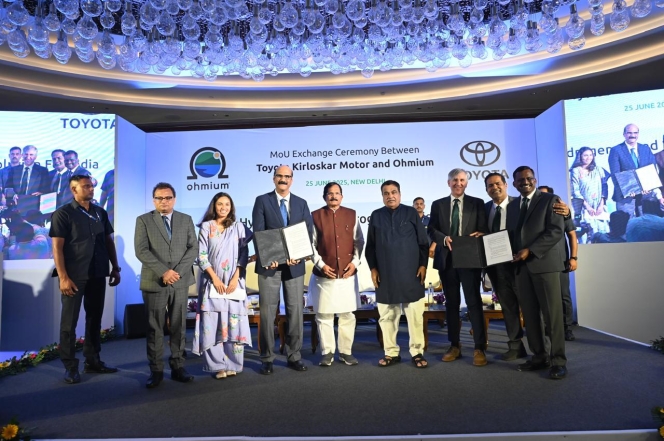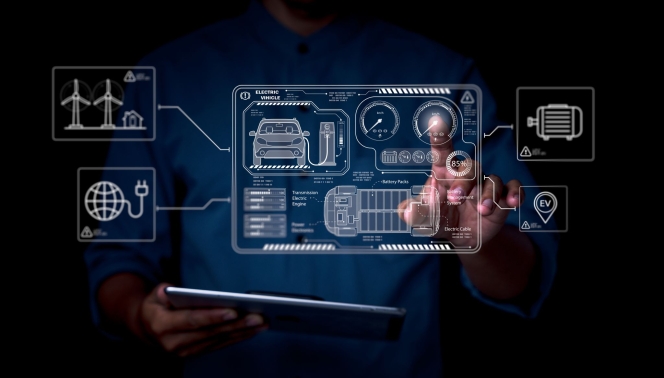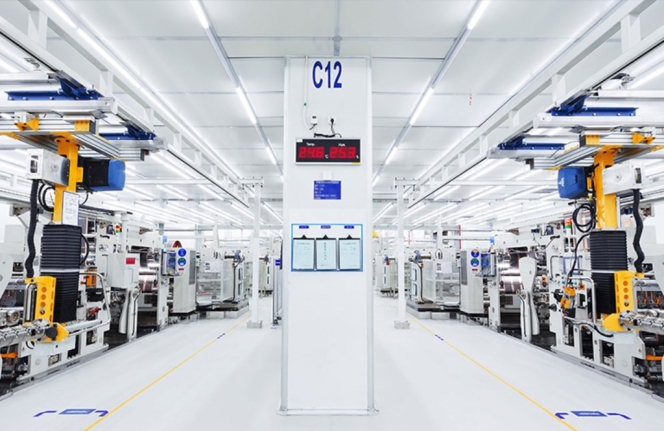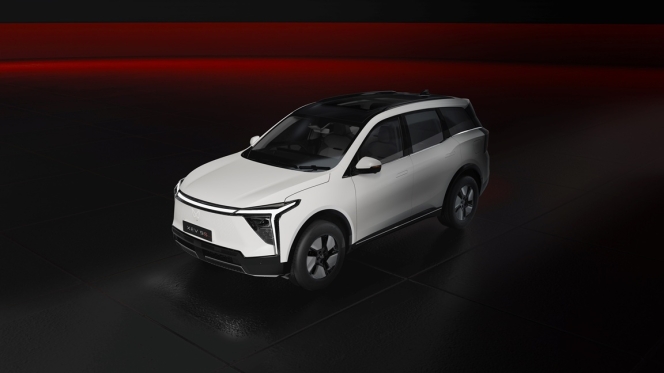- Toyota Kirloskar Motor
- Ohmium International
- electrolyser
- hydrogen
- iCAT
- Ashok Leyland
- Mira FCEV
- National Green Hydrogen Mission
- Nitin Gadkari
- MoRTH
- Shripad Yesso Naik
- Minister of New and Renewable Energy
- Manjinder Singh Sirsa
- Ahmad Chatila
- Manasi Tata
- Swpanesh R. Maru
Toyota Kirloskar Motor Partners With Ohmium To Co-Develop Green Hydrogen Power Solutions In India
- By MT Bureau
- June 26, 2025

Toyota Kirloskar Motor (TKM) has signed a Memorandum of Understanding (MoU) with Bengaluru-based Ohmium International to co-develop integrated Green Hydrogen-based power solutions in India.
This collaboration brings together Toyota’s expertise in fuel cell technology and Ohmium’s capabilities in scalable PEM electrolysers to explore applications such as microgrids for use in data centres and remote, environmentally sensitive areas. Toyota Kirloskar Motor will contribute technical know-how and fuel cell modules, while Ohmium will lead design and performance evaluations.
The initiative supports India’s National Green Hydrogen Mission and aligns with the country’s goals of energy independence by 2047 and net-zero emissions by 2070. It also marks a strategic expansion of Toyota’s hydrogen initiatives in India – from the 2022 Mirai FCEV pilot project with iCAT to its recent MoU with Ashok Leyland for hydrogen-powered commercial vehicles.
Through such partnerships, Toyota Kirloskar Motor aims to foster a robust hydrogen ecosystem in India, supporting both mobility and stationary power needs while advancing local innovation under the ‘Make in India’ vision.
Nitin Gadkari, Union Minister, Ministry of Road Transport and Highways, Government of India, said, “Hydrogen, as a clean and renewable energy source, is regarded as the fuel of the future – a key to building a self-reliant and carbon-neutral India. In this direction, the Government of India has been undertaking several progressive initiatives, fostering innovations across the energy and transportation ecosystems. Notably, numerous industry leaders, start-ups and researchers are unlocking new opportunities in the hydrogen space, aiming to drive sustainability across multiple domains. The adoption of strategic approaches to harness hydrogen’s full potential will be crucial in ensuring a clean, affordable, and source energy future for the nation. It is particularly encouraging to witness corporates and technology pioneers actively contributing to the development of scalable, indigenous hydrogen solutions that align with national priorities and the vision of a greener, more sustainable tomorrow. And I commend Toyota and Ohmium for making strong efforts with cleaner energy options through advanced hydrogen-led capabilities, aligning with the ‘Atmanirbhar Bharat Abhiyaan.”
Shripad Yesso Naik, Union Minister of State, Ministry of New and Renewable Energy, Government of India, said, “Initiatives that foster and promote scalable, home-grown solutions are essential to accelerating India’s transition to a low-carbon economy. In this regard, diverse sectoral industries will play a pivotal role in realising the goal of building a self-reliant green hydrogen ecosystem by 2030. Their innovative capabilities and localised solutions will form the backbone of India’s energy transition. The National Green Hydrogen Mission envisions India as a global leader in clean energy innovation and its deployment. To achieve this vision, it is imperative to strengthen domestic capabilities across the hydrogen value chain. Strategic collaborations such as this, between Toyota Kirloskar Motor and Ohmium, have the potential to significantly accelerate the progress towards a hydrogen-powered green energy future.”
Manjinder Singh Sirsa, Minister of Industries, Food & Supplies, Environment Forest and Wildlife, Government of NCT of Delhi, said, “As India continues to take strong strides in environmental leadership, initiatives like these reinforce our commitment to sustainable transformation at the grassroots. Green hydrogen presents a promising solution to reduce air pollution, drive industrial decarbonisation and enable the development of cleaner, future-ready ecosystem. The collaboration between Toyota Kirloskar Motor and Ohmium is a significant step forward – combining global innovation and local expertise to co-create scalable, green energy solutions. Such partnerships are essential to building sustainable industrial zones and pollution-free society, in line with our vision for a greener, healthier India.”
Ahmad Chatila, Ohmium Board Chaiman, said, “We are privileged to collaborate with Toyota Kirloskar Motor to integrate our locally manufactured electrolyser technology with their advanced fuel cell systems. This collaboration supports India’s Hydrogen economy goals and demonstrates our commitment to a greener future with cleaner air, better public health, and resilient, secure infrastructure.”
Manasi Tata, Vice-Chairperson, Toyota Kirloskar Motor, said, “At Toyota, our commitment to a carbon-neutral future extends beyond clean mobility. Green hydrogen is a vital part of this vision – not only for transportation but also its production, distribution, and diverse end-use applications. Through this collaboration with an innovative PEM technology player like Ohmium, we are not only advancing Hydrogen applications but also reinforcing our support for the country’s ‘Make in India’ initiative. By co-developing locally relevant hydrogen solutions, we aim to empower India’s energy transformation and contribute meaningfully to the hydrogen ecosystem.”
Swapnesh R. Maru, Deputy Managing Director, Corporate Planning, Green Field Project, Toyota Kirloskar Motor (TKM), said, “India stands at a transformative juncture in its clean energy journey, with a clear vision to achieve energy independence and long-term sustainability. At TKM, we are happy to contribute meaningfully to this future by adopting a multi-pathway approach. This allows us to diversify our environmental efforts and move with speed and at scale towards achieving carbon neutrality, in alignment with our national objectives. In this direction, our collaboration with Ohmium goes ‘Beyond Mobility’ – it’s a shared commitment to contributing towards the creation of a hydrogen-powered India that is self-reliant, resilient, inclusive, and future-ready. Guided by our deep respect for the planet, we see hydrogen not just as a fuel, but as a catalyst to usher in sustainability across mobility, energy and industry sectors. By integrating global expertise with India-focused innovation, we are proud to be delivering environment friendly solutions, fostering happier paths together.”
Trinseo Launches Fourth-Generation Binder For The Next Wave Of EV Batteries
- By MT Bureau
- December 03, 2025

Trinseo has introduced its latest innovation, the Fourth-Generation SBR Binder Platform, designed to meet the evolving demands of electric vehicles and battery energy storage systems. This development reflects the company's strategic focus on delivering high-performance materials essential for the global shift towards sustainable energy.
The platform results from advanced polymer science and collaboration with battery manufacturers, targeting key industry requirements such as increased energy density, superior durability and more efficient production. It provides a significant improvement in peel strength, enabling stronger electrode bonds, thicker coatings and higher manufacturing speeds. These attributes are vital for developing higher-capacity batteries that can extend driving range and improve storage solutions.
The inaugural product, VOLTABOND 109 Latex Binder, offers this next-generation performance with broad compatibility across various anode materials and manufacturing processes. Its design ensures excellent stability and low resistance, supporting faster charging and long-term reliability. To ensure robust supply, Trinseo will produce the platform locally within major global regions, enhancing responsiveness to battery production hubs.
Rooted in decades of expertise, this new platform establishes a foundation for future innovations tailored to diverse customer needs across the battery value chain.
CATL And Stellantis Begin Work On EUR 4.1 Billion Spanish Battery Plant
- By MT Bureau
- November 28, 2025

CATL and Stellantis broke ground on a EUR 4.1 billion battery plant in Figueruelas, Spain, on 26 November. The 50:50 joint venture will produce lithium-iron-phosphate battery cells and targets an annual production capacity of 50 GW/h.
The project, which is Spain’s largest battery factory, is backed by over EUR 300 million in EU funds, with production expected to start in late 2026.
According to unions, around 2,000 Chinese workers will help construct the site, a point of contention with local authorities and residents. Also, 3,000 Spanish staff are to be hired and trained later.
Spanish authorities and residents have voiced concerns about job opportunities for local workers and potential strain from the influx of foreign employees. CATL Vice President Meng Xiangfeng said earlier in November the company needed experienced technicians to build and fine-tune production lines, with plans to train local workers to take over operations gradually.
David Romeral, Director General of CAAR Aragon, a network of automotive businesses in the region, said: “We don’t know this technology, these components – we’ve never made them before. They’re years ahead of us. All we can do is watch and learn.”
The regional government is organising work permits for arriving workers while seeking to attract battery supply chain companies to Aragon. Some Chinese technicians and managers have already arrived, with several hundred more expected by year-end and nearly 2,000 by the end of next year.
CATL’s approach contrasts with its Hungarian site in Debrecen, where it hired mostly locals to build its European plant. However, a lack of local workers caused production to be delayed from late 2025 into mid-2026. The Figueruelas facility will serve as CATL’s third European manufacturing operation, alongside the Hungarian plant and one in Germany.
- Neuron Energy
- Equanimity Ventures
- Rajiv Dadlani Group
- Thackersay Family Office
- Chona Family Office
- Pratik Kamdar
- Rajesh Sehgal
- Rajiv Dadlani
Neuron Energy Secures INR 310 Million To Expand EV Battery Manufacturing For Four-Wheelers & Buses
- By MT Bureau
- November 27, 2025

Neuron Energy, an EV battery manufacturer, has raised INR 310 million in a Pre-Series B funding round led by Equanimity Ventures, Rajiv Dadlani Group, Thackersay Family Office and Chona Family Office, with participation from Family Offices and HNI investors. With this, Neuron Energy has raised INR 810 million to date.
The funding will be used to expand Neuron Energy’s manufacturing capacity to 3 GWh and to establish a fully automated, large-scale battery facility for electric four-wheelers and buses at Chakan, Pune. The capital will also strengthen the company’s R&D capabilities, accelerate domestic growth, and broaden its footprint in international markets.
Pratik Kamdar, CEO and Co-Founder, Neuron Energy, said, “This Pre-Series B round is a defining step in our mission to industrialise world-class battery manufacturing in India. As EV adoption accelerates, we are focused on building capacity, embedding automation, and pushing the boundaries of performance and reliability. This investment ensures we can deliver at scale, both in India and globally.”
The company said it operates with a low-CapEx and low-OpEx business model. It has been growing profitably year-on-year and is on track to achieve INR 2 billion in revenue this year. The company is also confident of achieving sales of over INR 9 billion, with profitability, over the next few years.
Rajesh Sehgal of Equanimity Ventures, added, "We see immense potential in Neuron Energy’s approach to EV battery innovation and scalability. Their focus on quality, automation, and energy efficiency aligns with the evolving demands of the EV industry in India and beyond. We are proud to support their next phase of growth as they scale into new vehicle categories and manufacturing capacities."
The new facility reinforces the company’s position in two-wheeler EV batteries and signals a strategic entry into heavier vehicle segments. This supports Neuron’s vision to become a comprehensive EV battery solutions provider.
Rajiv Dadlani, from the Family Office of the Rajiv Dadlani Group, said, "Neuron Energy demonstrates remarkable potential to become the market leader, with their renewed focus, in delivering top-quality products. The company and its founders are highly committed to delivering rigorously tested and safe-to-use Li-Ion smart batteries. We are confident that they will continue to thrive and set new standards in the industry."
Mahindra Intros XEV 9S Electric 7-Seater SUV At INR 1.99 Million, Deliveries From 23 January
- By MT Bureau
- November 27, 2025

Mahindra has launched the XEV 9S, an electric 7-seater SUV built on the INGLO platform, with prices starting at INR 1.99 million (ex-showroom). The XEV 9S is powered by MAIA, described as India’s fastest automotive mind.
The EV comes with a 70 kWh battery, delivering a power of 180 kW and 380 Nm of torque. It offers a claimed real-world range of 500 km from its LFP battery, which comes with a Lifetime Warranty. The SUV is stated to be the fastest 7-seater in its class, reaching zero to 100 kmph in 7.0 seconds, with a 202 kmph top speed.
The fully-loaded Pack Three Above 79 kWh variant is priced at INR 2.94 million ex-showroom with bookings open on 14 January 2026 and deliveries starting on 23 January 2026.
R Velusamy, President - Automotive Business, Mahindra & Mahindra and Managing Director, Mahindra Electric Automobile, said, “We have always believed that technology is meaningful only when it expands human possibility. The XEV 9S built on the INGLO electric origin platform does exactly that by creatin space – more than anyone else and gives a smooth and noise free ride. THE MAIA brain enables many of its high-tech features, making it the most advanced offering for its price.”
Nalinikanth Gollagunta, Chief Executive Officer - Automotive Division, Mahindra & Mahindra and Executive Director, Mahindra Electric Automobile, said, “The future of Indian mobility will belong to brands that don’t just electrify vehicles, but reimagine categories. With the XEV 9S, we’re not just playing in the EV segment, we’re expanding it. This SUV signals the start of a BIG new electric era for Mahindra - one built on scale, on purpose, and on a deep understanding of how India moves. The attractive prices starting at ₹ 19.95 Lakh make a very high-tech product accessible, with bookings opening on Jan 14 and deliveries start on Jan 23.”
The XEV 9S is an expression of Mahindra’s Heartcore Design philosophy, featuring a stance, lines, a gloss finish and interiors. The vehicle is designed to be silent on wheels.
Key highlights include:
- Space: Offers 4,076-litre of cabin space (for front and second row), boot space up to 527-litre and 150-litre of Frunk space. The third-row features 50:50 split seats.
- Suspension: Features Intelligent Adaptive dampers with i-Link at the front and 5-Link independent suspension at the rear.
- Driver Aids: Includes L2+ ADAS with five Radars and one Vision Camera, Driver Drowsiness Detection with DOMS (Eyedentity) and Secure360 Pro for live view and recording.
- Interior Comfort: Features Powered Boss Mode, ventilated second row seats, recline and sliding adjustment, sunshade for second row windows, Acoustic ‘Laminated’ Glass and wireless phone charging.
- Technology: Equipped with Brake by Wire with IEB, High Power Steering with VGR, VisionX – AR HUD, AutoPark Assist, and 140 features including Digital Key, NFC and Charge Scheduler.
- Entertainment: Includes a 16-Speaker Harman Kardon Audio system with Dolby Atmos, three 31.24 cm screens, 5G Connectivity and Fun & Work Apps.
- Efficiency: Running costs are INR 1.2 per km, with maintenance costs of INR 40 paise per kilometre and negligible road tax. Business owners benefit from 40 percent depreciation.
Pratap Bose, Chief Design & Creative Officer - Auto & Farm Sectors, Mahindra & Mahindra, said, “Designing the XEV 9S wasn’t about adding lines to a surface, it was about shaping a feeling. We wanted it to feel like stepping into a personal sanctuary, yet one that carries the pulse of modern India. Electric gave us the canvas; INGLO gave us the freedom to sculpt light, space and comfort. The result is an SUV that wears its size with grace and its technology with humility. It’s expressive, it’s calm, and it’s unmistakably Mahindra - built for a nation whose aspirations are only getting bigger.”






Comments (0)
ADD COMMENT